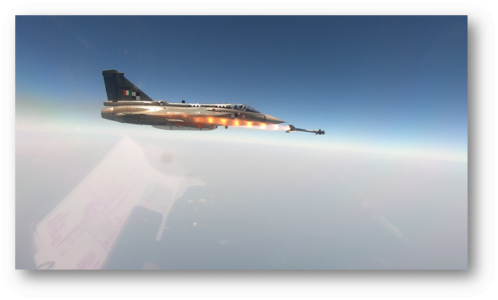DRDO conducts maiden trial of Python-5 Air to Air Missile
Context:
Tejas, India’s indigenous Light Combat Aircraft, added the 5th generation Python-5 Air-to-Air Missile (AAM) in its air-to-air weapons capability on April 27, 2021. Trials were also aimed to validate enhanced capability of already integrated Derby Beyond Visual Range (BVR) AAM on Tejas.
About Python Missile:
- The Rafael Python is a family of air-to-air missiles (AAMs) built by the Israeli weapons manufacturer Rafael Advanced Defense Systems, formerly RAFAEL Armament Development Authority.
- Originally starting with the Shafrir series, the Shafrir-1 missile was developed in 1959, followed by the Shafrir-2 in early 1970s.
- Subsequently, the missiles were given the western name of “Python” by the parent company for export purposes, starting with the Python-3 in 1978.
- Since then, it has been further developed and evolved into the Python-4, Python-5, Derby and also, the SPYDER, an advanced ground-based air-defence system.
- Currently, the missiles are in service with the armed forces of over fifteen countries from around the world.
Python-5
The Python-5 is currently the most capable air-to-air missile in Israel’s inventory and one of the most advanced AAMs in the world. As a beyond-visual-range missile, it is capable of “lock-on after launch” (LOAL), and has full-sphere/all-direction (including rearward) attack ability. The missile features an advanced seeker which includes an electro-optical and image infrared homing seeker which scans the target area for hostile aircraft, then locks-on for terminal chase. With a total of eighteen control surfaces and careful design, the resulting missile is supposed to be as maneuverable as any other air-to-air missiles with thrust vectoring nozzles. The Python-5 was first used in combat during the 2006 Lebanon War, when it was used by F-16 Fighting Falcons to destroy two Iranian-made Ababil UAVs used by the Hezbollah.
- Guidance: IR + electro-optical imaging
- Warhead: 11 kg
- Range: >20 km
- Speed: Mach 4
Earlier Variants
Shafrir-1
The Shafrir-1 was developed in 1959–1964 to fulfill IAF’s requirement for a domestic air-to-air missile. It was intended to build the domestic defense industry’s abilities, and reduce reliance on foreign imports. The fear of foreign dependence was later proven when France banned arms export to Israel.
The Shafrir-1 was intended for use on French-built Mirage jets. The first testing took place in France in 1963. However the missile’s performance was so poor that they immediately started on the next improved version, the Shafrir-2.
- Length: 250 cm (2.5 m)
- Span: 55 cm
- Diameter: 14 cm
- Weight: 65 kg
- Guidance: IR
- Warhead: 11 kg blast explosive, later 30 kg
- Range: 5 km
- Speed: ??
Shafrir-2
The Shafrir-2 was credited with 89 kills in the 1973 Yom Kippur War. During its whole service life, it is credited with a total of 106 kills.
- Length: 250 cm (2.5 m)
- Span: 55 cm
- Diameter: 15 cm
- Weight: 93 kg
- Guidance: IR
- Warhead: 11 kg
- Range: 5 km
- Speed: ??
Python-3
Python 3 missile under the wing of an Israeli F-15 Eagle.
The Python-3 is a much-improved AAM with all-aspect attack ability, higher speed, range, and performance. It performed well before and during the 1982 Lebanon War, scoring 35 (other sources claim 50) kills.
China’s PLAAF was quite impressed with this missile, and paid for licensed production as the PL-8 AAM in the 1980s. The program code named “Number 8 Project” and formally started on September 15, 1983. From March 1988 to April 1989, technology transfer to China was complete while license assembly and license built parts continued, and by the spring of 1989, the complete domestic Chinese built missile received state certification. The major supplier of the missile was Xi’an Eastern Machinery Factory located at Xi’an, and China is also reported to have developed a helmet-mounted sight (HMS) system for the PL-8.
- Length: 295 cm
- Span: 80 cm
- Diameter: 16 cm
- Weight: 120 kg
- Guidance: IR
- Warhead: 11 kg, active proximity fuse
- Range: 15 km
- Speed: Mach 3.5
Python-4
A Python 4 missile under the wing F-15D Baz ‘957’
The Python-4 is a 4th generation AAM with all-aspect attack ability, and integration with a helmet-mounted sight (HMS) system.[6] It entered service in the 1990s, and like its predecessor Python-3, it is integrated with the Elbit Systems DASH (Display And Sight Helmet) HMS system for Israeli F-15s and F-16s, Chilean F-16s (MLU and C/D block 50/52 plus), F-5E/F Tiger III, South American Kfirs and the SAAB JAS 39 Gripen. The missile’s seeker is reported to use dual band technology array similar to that of US FIM-92 Stinger (infrared homing and ultraviolet), with IRCCM (IR ECCM) ability to reduce background IR radiation to reduce the effectiveness of enemy flares.[9]
- Length: 300 cm
- Span: 50 cm
- Diameter: 16 cm
- Weight: 120 kg
- Guidance: IR
- Warhead: 11 kg, active laser proximity fuse with back-up impact fuse
- Range: 15 km
- Speed: Mach 3.5 or more
Source: PIB



